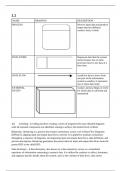1.1
NAME DRAWING DESCRIPTION
PROCESS Receive input data and produce
output that has different
content, form, or both
DATA STORE Represent data that the system
stores because one or more
processes have to use data at a
later time
DATA FLOW A path for data to move from
one part of the information
system to another, it represents
one or more data items
EXTERNAL A place, person, things or event
ENTITY for which data is collected and
maintained
1.2 Levelling - Levelling involves creating a series of progressively more detailed diagrams
until all essential components are identified, aiming to achieve the desired level of detail.
Balancing - Balancing is a process that ensures consistency across a set of Data Flow Diagrams
(DFDs) by aligning input and output data flows correctly. It is applied to maintain consistency
throughout a sequence of diagrams, encompassing input and output data flows, data definition, and
process descriptions. Balancing guarantees the preservation of input and output data flows from the
parent DFD to the child DFD.
Data dictionary - A data dictionary, also known as a data repository, serves as a centralized
repository of information concerning a system's data. It is utilized by analysts to collect, document,
and organize specific details about the system, such as the contents of data flows, data stores,
, entities, and processes. Additionally, the data dictionary defines and describes all data elements and
meaningful combinations of data elements.
1.3
Spontaneous generation
Black hole
Gray hole




